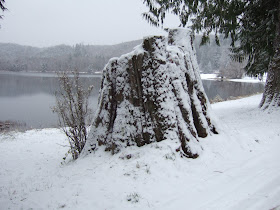Dead Western Red Cedar with wood cut
Dead western red cedar in salt marsh
I have utilized trees to help me understand the landscape I am seeing. A few examples follow.
Western red cedar stump near the toe of a slope
This winter I inspected a steep slope above this tree. I was fairly sure the slope was stable based on test pits, slope angles and a variety of other observations. This tree let me know that at least for the past 200 years or so there had not been a large landslide from the slope above.
Boulder and Douglas fir
In this case I knew that I was on a landslide deposit. At the very least I knew that the slide predated the trees growing in this forest. I found very large cedar stumps in this forest as well indicating that the slide was at least 400 years old. A similar slide in the same area was dated by extracting buried wood underneath the landslide deposit.
A worn out Sam next to a old growth western red cedar on an alluvial fan
The huge cedar stump pictured above was growing on an alluvial fan. The presence of the tree without any apparent burial of its base by sediment provided me with some sense of the potential risk of large debris flows and that the rate of deposition and run out of debris flows on this fan.
This tree stump on an unstable slope was approximately 50 years old when cut down
I spotted this stump on a slope that I knew was likely to fail, but the stump gave me at least one means of estimating the frequency of failures on this slope. It was not a very big tree when it was cut down reflecting the harsh growing conditions on this slope. The tree had been cut 40 years ago. So at this one site I could say that the slope had been there for nearly 100 years.
Some caution should be applied particularly with regards to slope stability as past conditions on or below or above a slope may have changed significantly due to land use changes. Straight trees on a slope does not mean the slope is stable. It just means it has not moved for a while.
These trees were straight when I first visited this slope.
The whole slope started moving four months later.








No comments:
Post a Comment